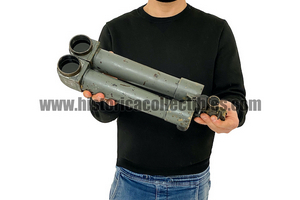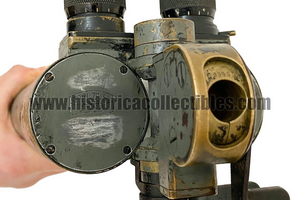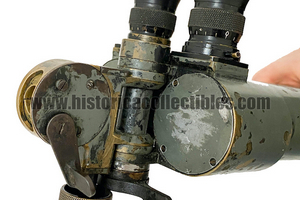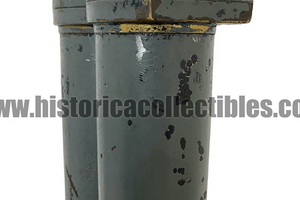gr. Scherenfernrohr, Carl Zeiss, M. 15 Z. Austro Hungarian/Artillery Reichsmarine Weimar, 1915
gr. Scherenfernrohr, Model M. 15 Z., produced by Carl Zeiss, Jena in 1915 in few examples, supplied to the German Army during the First World War and reused by the German artillery forces of the Reichsmarine Weimar until 1933.
Of exceptional rarity is the presence, on the right objective side, of the marks relating to the Reichsmarine Artillery of Weimar: In fact, this Scherenfernrohr, in addition to being one of the very few known examples, is a very important historical testimony of the events that followed the First World War World. With the Treaty of Versailles, stipulated as part of the Paris Peace Conference of 1919-1920 and signed by 44 states, on 28 June 1919 in Versailles, divided into 16 parts and composed of 440 articles, the German peace delegation accepted heavy army reductions, heavy war reparations payments, and the so-called "Germany was solely responsible for the outbreak of war" clause.
The Treaty of Versailles, in addition to abolishing conscription for Germany, also placed major limitations on the German armed forces, which were not to exceed 100,000 units and a drastic reduction in the production of war material.
In fact, in the face of this, a small part of the technical and optical instrumentation left over from the First World War was reused and used to equip the "new" German army reconstituted under the flag of the Weimar Republic: so it was that in this Scherenfernrohr they were canceled , acceptance mark by the Austro-Hungarian Army and the date of military acceptance and placed, on the right objective plate, the acceptance mark of the Reichsmarine Artillerie of Weimar.
It was only from 1 October 1924, the year in which Admiral Paul Behncke retired from active service and was replaced as director of the Marineleitung by Vice Admiral Hans Zenker, that the modernization programs of the German fleet were carried forward, also benefiting from Germany's economic recovery under the government of chancellors Gustav Stresemann and Wilhelm Marx.
It was between 1924 and 1925 that the navy, not being able to produce optics and instruments from scratch to reorganize military supplies, decided to reuse surviving but still efficient instruments from the First World War.
The manufacturer's brand "C. Zeiss Wien" is shown on the left eyepiece plate, while the information relating to the model is shown on the right eyepiece plate, "M. 15 Z." and "N.X".
This model has some construction details which, obviously, differentiate it from all other models such as the absence of the eyepiece guide bar which regulates the interpupillary distance, therefore the eyepieces do not rotate together with it but rather are independent and most likely the the abbreviation "N. X" indicates the progressive serial number of specimens produced.
The view is perfectly sharp and collimated. On the right eyepiece there is a reticle that can be adjusted using a special lever. All mechanisms work perfectly.
It is currently the only known specimen with these characteristics.
Carl Zeiss takes its name from its founder, Carl Zeiss, who on November 17, 1846 chose the small town of Jena, in Thuringia, as the location for his precision optical equipment factory.
Thanks to the severe quality control that Carl Zeiss imposed on his products, going so far as to personally destroy the microscopes that did not pass the tests, the newly formed Zeiss became the official supplier of the University of Jena and received the gold medal of the industrial exhibition in 1861 of Thuringia as the best research instrument produced in Germany, awarded to the Stand I microscope of 1857.
In 1866 the thousandth microscope was produced and the name Zeiss became known in all European scientific circles. Thanks to studies on the Porro prism, in 1893 Abbe patented double prism binoculars, which accentuated the perception of depth.
The mass production of Zeiss binoculars began in 1894, already at the beginning of the twentieth century more than 30,000 were made, at the beginning of the First World War the quota had risen to 500,000 and, at the end of the Second World War, as many as 2,260,000 were produced binoculars for the civil and military market. Models were made starting from 4x11 mm to 12x40 mm, up to real giants such as the 80 mm and 100 mm.
Thanks to studies conducted on the perception of light in low light situations, it was demonstrated that the average dilation of the pupil in an adult is approximately 7 mm. For this reason, the 7x50 mm model was introduced in 1910 and remained on the market until 1917 with few changes to the materials used.
In 1926, following the post-war crisis of the First World War with the Treaty of Versailles which bankrupted many important German companies, Zeiss purchased "C.P. GOERZ" and founded Zeiss Ikon in 1926.
In 1937 Zeiss had commercial contacts and factories in more than 29 countries around the world. From '33 Zeiss acquired interest from the Nazi regime, which balanced production towards military instruments.
It successfully produced binoculars with wide-angle optics for military use, pressure-resistant optical systems for U-boats, periscope binoculars for targeting tanks. Furthermore, Zeiss cameras were mounted on the V2s for remote sensing operations of the English coasts.
On 1 November 1935, Zeiss, in the figure of Alexander Smakula, patented a process for the treatment of optical glass with extraordinary results in terms of light transmission. Remained a military secret until 1939, it was adopted on binoculars to reduce ghost images and internal reflections.
During the Second World War, there were numerous bombings against the Zeiss factories. Jena was bombed several times by the Allies starting in 1944. Stuttgart was razed to the ground, although the Contessa-Nettel factory suffered little damage. The bombing of Dresden, in addition to devastating the city, also caused considerable damage to the Zeiss Ikon headquarters.
On April 13, 1945, American military forces entered Jena, surprising themselves that the bombing had not caused any significant damage. The main planetarium was in ruins, while the factories remained operational.





